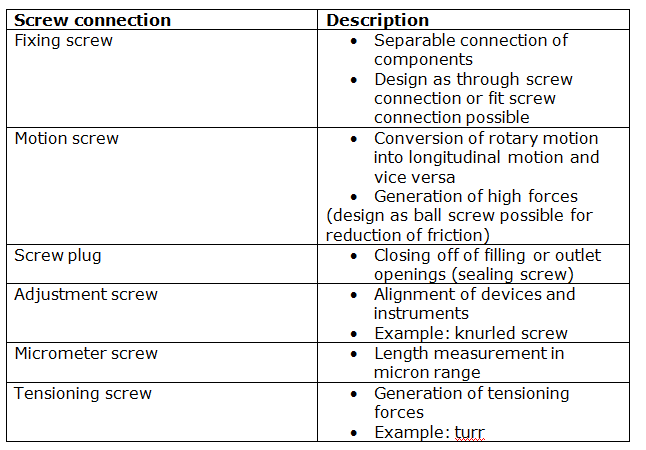Form fit and frictional locking connections
Screw connections are based on a combination of a screw or grub screw with an external thread and a component with an internal thread (normally a nut) where form fit between the two is achieved in the thread.
In the thread, which can be seen in an unwound form as a skewed plane, rotation of the screw relative to the nut gives sliding of the thread flanks of the screw on the thread flanks of the nut and thereby longitudinal motion.
Depending on the intended purpose, a distinction is made between various types of screw design.

Fixing screws
Screws are the most widely used machine elements for joining components. In comparison with welded, soldered, bonded and riveted joints, components can be separated non-destructively and joined again. As a fixing element, the screw must perform the task of connecting components under the preload force applied during assembly and of maintaining this connection in the event of static and dynamic loads.
In contrast to the advantages of the screw connection, which lie in its simple assembly, non-destructive separability and ability to transmit large forces, there is the drawback that the highly notched screw may suffer fatigue fracture under dynamic loads or that an inadmissible breakdown of the preload force may occur in the joint as the result of settling phenomena at the contact points, or as a result of the nut working loose from the screw. A screw connection subjected to high loads will survive or fail depending on the ability of its screws to maintain or lose the preload force applied during assembly. Very often, the cause of a fatigue fracture in a screw can be attributed to a prior reduction in the preload force. It is therefore imperative that a screw connection should be carefully designed and calculated.
Through screw connections
Characteristics:
- Frictional locking connection
- Clamping force generated by tightening of the nut
- Screw subjected to tensile load (torsion due to the tightening torque)
- Securing of screw necessary
- Additional centring necessary
Properties:
- Separable connection
- Suitable for large forces
- Easy to fit
- Stress concentration due to hole in the flange (notch effect).

